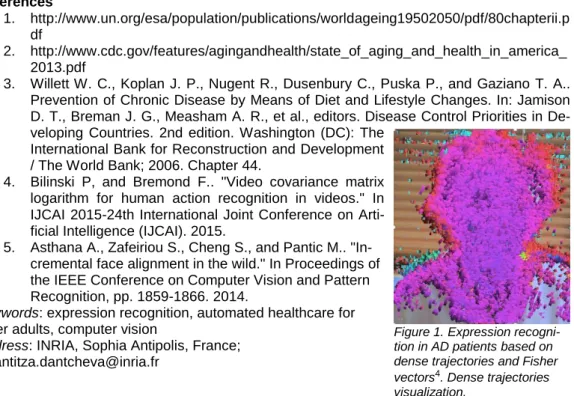HAL Id: hal-01446930
https://hal.archives-ouvertes.fr/hal-01446930
Submitted on 9 Mar 2017
HAL is a multi-disciplinary open access
archive for the deposit and dissemination of
sci-entific research documents, whether they are
pub-lished or not. The documents may come from
teaching and research institutions in France or
abroad, or from public or private research centers.
L’archive ouverte pluridisciplinaire HAL, est
destinée au dépôt et à la diffusion de documents
scientifiques de niveau recherche, publiés ou non,
émanant des établissements d’enseignement et de
recherche français ou étrangers, des laboratoires
publics ou privés.
Emotion facial recognition by the means of automatic
video analysis
Antitza Dantcheva, Piotr Bilinski, Jean Claude Broutart, Philippe Robert,
Francois Bremond
To cite this version:
Antitza Dantcheva, Piotr Bilinski, Jean Claude Broutart, Philippe Robert, Francois Bremond.
Emo-tion facial recogniEmo-tion by the means of automatic video analysis. Gerontechnology, ISG InternaEmo-tional
Society for Gerontechnology, 2016. �hal-01446930�
Gerontechnology 2016. Emotion facial recognition by the means of automatic video analysis.
A. Dantcheva, P. Bilinski, J. C. Broutart, P. Robert, F. Bremond.
Emotion facial recognition by the means of automatic video analysis.
A. DANTCHEVA,P.BILINSKI,J.C.BROUTART,P.ROBERT,F.BREMOND. Gerontechnology 2016;15(suppl); doi:10.4017/gt.2016.15.s.939.00
Purpose The elderly population has been growing dramatically and future predictions and
estimations showcase that by 2050 the number of people over 65 years old will increase by 70%, the number of people over 80 years old will increase by 170%, outnumbering younger generations from 0-14 years1. Other studies indicate that around half of the current population
of over 75 year olds suffer from physical and / or mental impairments and as a result are in need of high level of care2. The loss of autonomy can be delayed by maintaining an active life
style, which also would lead to reduced healthcare financial costs3. With the expected
in-crease of the world elderly population, and on the other hand limited available human re-sources for care a question arises as ”How can we improve health care in an efficient and cost effective manner?”.
Method Motivated by the above, we propose an approach for detecting facial expressions in
Alzheimer’s disease (AD) patients that can be a pertinent unit in an automated assisted living system for elderly subjects. Specifically, we have collected video-data of AD patients in musi-cal therapy at the AD center Fondation G.S.F J. L. Noisiez in Biot, France from multiple thera-py-sessions for validating our method. We note that in such sessions even AD patients suffer-ing from apathy exhibit a number of emotions and expressions. We propose a spatio-temporal algorithm for facial expression recognition based on dense trajectories, Fisher Vectors and support vector machine classification4. We compared the proposed algorithm to a
facial-landmark-based algorithm concerning signal displacement of tracked points within the face5.
Results & Discussion Our algorithm differentiates between four different facial expressions:
(i) neutral, (ii) smile, (iii) talking, and (iv) singing with an accuracy of 56%, outperforming the facial-landmark-based algorithm. Challenging for both algorithms has been the unconstrained setting involving different poses, changes in illumination and camera movement. One ex-pected benefit for AD patients is that positive expressions and their cause could be deter-mined and replicated in order to increase life standard for such patients, which also brings to the fore a delay in the development of AD.
References
1. http://www.un.org/esa/population/publications/worldageing19502050/pdf/80chapterii.p df
2. http://www.cdc.gov/features/agingandhealth/state_of_aging_and_health_in_america_ 2013.pdf
3. Willett W. C., Koplan J. P., Nugent R., Dusenbury C., Puska P., and Gaziano T. A.. Prevention of Chronic Disease by Means of Diet and Lifestyle Changes. In: Jamison D. T., Breman J. G., Measham A. R., et al., editors. Disease Control Priorities in De-veloping Countries. 2nd edition. Washington (DC): The
International Bank for Reconstruction and Development / The World Bank; 2006. Chapter 44.
4. Bilinski P, and Bremond F.. "Video covariance matrix logarithm for human action recognition in videos." In IJCAI 2015-24th International Joint Conference on Arti-ficial Intelligence (IJCAI). 2015.
5. Asthana A., Zafeiriou S., Cheng S., and Pantic M.. "In-cremental face alignment in the wild." In Proceedings of the IEEE Conference on Computer Vision and Pattern Recognition, pp. 1859-1866. 2014.
Keywords: expression recognition, automated healthcare for older adults, computer vision
Address: INRIA, Sophia Antipolis, France; E: antitza.dantcheva@inria.fr
Figure 1. Expression recogni-tion in AD patients based on dense trajectories and Fisher vectors4. Dense trajectories
